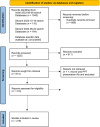Alpha-Gal Syndrome: Often Hidden, Under-Recognized, and in Need of Attention-A Rapid Review
- PMID: 40600132
- PMCID: PMC12212072
- DOI: 10.2147/IJGM.S519844
Alpha-Gal Syndrome: Often Hidden, Under-Recognized, and in Need of Attention-A Rapid Review
Abstract
Alpha-gal syndrome (AGS), a tick-borne allergy, is increasing as its vectors migrate throughout the US and the world. There were an estimated 450,000 cases in the US. AGS reactions to mammalian foods and medical products include delayed anaphylaxis, urticaria, gastrointestinal and cardiac symptoms often difficult to connect to the source. Despite its seriousness, provider knowledge is limited. This rapid review investigated published works on AGS from 2020 to 24; it also sought to determine the breadth of AGs publications across different fields and specialties. We identified 355 studies of AGS diagnosis and management from 2020 to 2024 via Cochrane Central, Medline via the PubMed interface, and Embase (additional grey literature via Web of Science and Google Scholar). Studies were assessed for quality and risk of bias using JBI critical appraisal tools. Two hundred and nineteen studies met the criteria. One hundred and sixty-eight (77%) were full studies; 51 (23%) were conference presentations. Studies remained largely confined to allergy and immunology literature, despite their implications for other organ systems. Although patients present with symptoms to emergency departments and dermatology clinics there is a paucity of literature in those fields and others; several studies document practitioners' lack of knowledge. Inclusion of content within medical school curricula is needed to establish foundational knowledge on the topic. With the increase in patients presenting with AGS, and with the reach of AGS across multiple fields, physicians and other health care providers need to be able to diagnose and then manage AGS with their patients. This rapid review has documented the problem of silos in disseminating information about AGS widely through the medical field. The remedy for a lack of practitioner knowledge is education.
Keywords: allergy; immunology; mammalian products; provider knowledge; red meat; tick-borne.
© 2025 Thompson et al.
Conflict of interest statement
The author(s) report no conflicts of interest and no financial interest in this work.
Figures
Similar articles
-
The experience of adults who choose watchful waiting or active surveillance as an approach to medical treatment: a qualitative systematic review.JBI Database System Rev Implement Rep. 2016 Feb;14(2):174-255. doi: 10.11124/jbisrir-2016-2270. JBI Database System Rev Implement Rep. 2016. PMID: 27536798
-
Interventions for interpersonal communication about end of life care between health practitioners and affected people.Cochrane Database Syst Rev. 2022 Jul 8;7(7):CD013116. doi: 10.1002/14651858.CD013116.pub2. Cochrane Database Syst Rev. 2022. PMID: 35802350 Free PMC article.
-
Health professionals' experience of teamwork education in acute hospital settings: a systematic review of qualitative literature.JBI Database System Rev Implement Rep. 2016 Apr;14(4):96-137. doi: 10.11124/JBISRIR-2016-1843. JBI Database System Rev Implement Rep. 2016. PMID: 27532314
-
Signs and symptoms to determine if a patient presenting in primary care or hospital outpatient settings has COVID-19.Cochrane Database Syst Rev. 2022 May 20;5(5):CD013665. doi: 10.1002/14651858.CD013665.pub3. Cochrane Database Syst Rev. 2022. PMID: 35593186 Free PMC article.
-
Eliciting adverse effects data from participants in clinical trials.Cochrane Database Syst Rev. 2018 Jan 16;1(1):MR000039. doi: 10.1002/14651858.MR000039.pub2. Cochrane Database Syst Rev. 2018. PMID: 29372930 Free PMC article.
References
Publication types
LinkOut - more resources
Full Text Sources
Miscellaneous


